Entries Categorized as 'Monet’s House'
December 17, 2012
[singlepic id=233 w=320 h=240 float=left]Here is another view of Claude Monet’s yellow dining room at Giverny. Bright, charming, cozy, it is often considered inspiring by people seeking new ideas for their home.
The red and creamy tiles on the floor are typical for the local 19th Century style and can be found in many houses around. The furniture, including buffets and chairs, was also widely spread. Monet’s novelty was to paint it in these two tones of yellow.
Nevertheless, a strange spell lies on this dining room. Many visitors remember it as the “yellow kitchen”. However, the neighboring kitchen is absolutely blue, as you can spot through the door.
Posted in Monet's House 15 Comments »
October 5, 2012
[singlepic id=229 w=320 h=240 float=left]Next year, the Easter week-end is the last week-end of March.
The direction of Fondation Claude Monet has thus decided exceptionnally to open the gardens of Giverny on Saturday 30 March at 9.30am.
This will be two days earlier than the normal date.
Read the rest of this entry »
Posted in Giverny, Monet's House 11 Comments »
May 28, 2012
[singlepic id=220 w=320 h=240 float=right]The painter Claude Monet had a special eye for refined and simple countryside elegance.
Here, the main entrance to his home at Giverny, an harmony of tender pink and bright green, enhanced by two blue Chinese pots.
The balance is obtained by the symetry of the decoration.
The curtains behind the iron cast door make it look like a puppet theatre.
Posted in Monet's House 2 Comments »
April 8, 2012
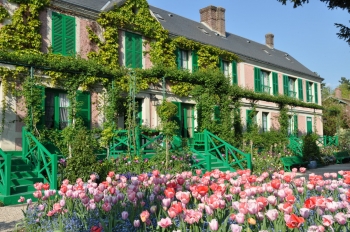 In April, the pink facade of Monet’s house in Giverny responds to huge beds of pink tulips in front of the main entrance.
In April, the pink facade of Monet’s house in Giverny responds to huge beds of pink tulips in front of the main entrance.
To create a shimmering effect, several varieties of pink tulips are planted, some redder, pinker or even orange, to resemble Monet’s brushstrokes on the canvas.
The pink tulips are underplanted by blue forget-me-not.
Posted in Monet's House No Comments »
March 1, 2012
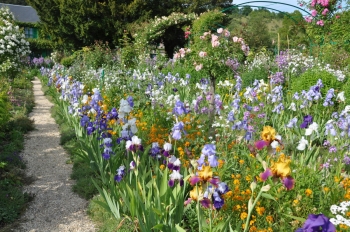 Monet’s House and Garden at Giverny will open in exactly one month, on April 1st. You can already buy your admission tickets on-line, by following this link.
Monet’s House and Garden at Giverny will open in exactly one month, on April 1st. You can already buy your admission tickets on-line, by following this link.
It is wise to buy your ticket in advance, because lines can be long sometimes, especially on sunny days.
In 2012, the admission fare at the till is 9 euros for an adult, 5 euros for young people between 7 and 25 (free for kids up to 6 years old). For an e-ticket you will pay an extra cost, but it is not expensive.
You can book your admission for any day from 1st April to 1st November, 2012. Fondation Monet is open 7/7. The best day to come is generally Wednesday. The best time: late afternoon, after 4.00pm, on week-days, because most visitors leave early to get back to Paris.
Or, on week-end, a good tip is to come early in the morning. With your e-ticket you can get in as early as 9.15am.
When in Giverny, make your way to the Group Entrance with your advance ticket, (not the individual entrance, because it is for people who don’t have their ticket). The Group Entrance is located at the bottom of the garden in a small lane called ruelle Leroy. It is next to the road D5 coming from Vernon.
You will show your e-ticket to a security member, and in you are! It is only a few steps to the water garden.
I really recommend purchasing e-tickets, because many people are very surprised to see how busy Giverny is. 611 000 visitors came in 2011, all of them within 7 months only!
To make most of your time and enjoy the very special atmosphere of Monet’s gardens, choose carefully the day of your visit. Unless it rains, you can expect crowds on long week-ends in Spring like Easter, 1st and 8th of May, Ascension Day, Whit Sunday. Your vacation time is short, it is not fun to waste it queuing.
Posted in Monet's flower garden, Monet's House 27 Comments »
December 2, 2011
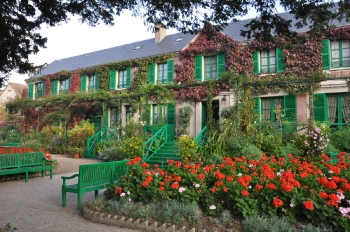 Flashing reds and greens in the soft light of October, this is what Monet’s garden offers in October in the area in front of the painter’s house.
Flashing reds and greens in the soft light of October, this is what Monet’s garden offers in October in the area in front of the painter’s house.
The “Monet green” spreads on benches, shutters, stairs… creating a strong contrast with the formal geranium beds and the virginia creeper on the façade.
Posted in Monet's House No Comments »
November 10, 2011
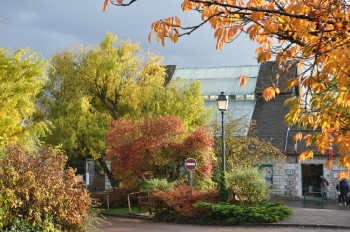 Monet was 76 when he decided he needed a new studio. This one is actually the third one he built on the premises.
Monet was 76 when he decided he needed a new studio. This one is actually the third one he built on the premises.
After having turned a former barn with western light into his first studio, errected the second one with a big window on the northern facade, Monet decided he wanted the light to fall from the sky, and not from any other direction.
This is why the third studio has huge skylights. The entire roof is made out of glass.
Posted in Monet's House 1 Comment »
September 29, 2011
[singlepic id=187 w=320 h=240 float=right]A look through the window of Monet’s studio, on the ground floor of his house at Giverny.
The garden appears like an additional painting among the canvases hanging on the wall.
Posted in Monet's House No Comments »
April 3, 2011
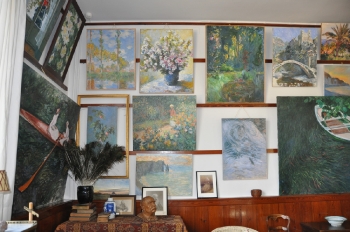 Sixty replicas, that is to say very good copies, have just been hung on the walls of Monet’s first studio at Giverny, making the place even more atmospheric.
Sixty replicas, that is to say very good copies, have just been hung on the walls of Monet’s first studio at Giverny, making the place even more atmospheric.
Untill last year, visitors could see prints on canvas on the walls. The new copies are now real paintings on canvas. They were made by a French gallery, galerie Trubetskoy in Paris. The chosen pictures were all in Monet’s own collection of his own work in his late years. These were the paintings he loved most and didn’t want to sell.
In addition, all the details of the studio have been checked on old photographs to be as accurate as possible. The result is stunning and really moving.
Posted in Monet's House 4 Comments »
January 27, 2011
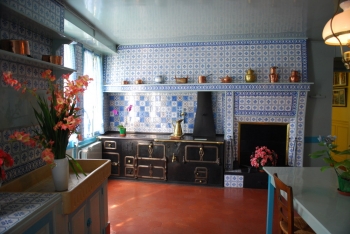 Very striking in Claude Monet’s kitchen at Giverny are the blue tiles that cover all the walls.
Very striking in Claude Monet’s kitchen at Giverny are the blue tiles that cover all the walls.
Posted in Monet's House 9 Comments »
December 31, 2010
[singlepic=169,350,350,,right]My German friend Veronika Stark painted this view of Monet’s garden under the snow.
It has been white for almost two weeks lately, but now the snow has gone.
I wish you all a wonderful celebration of New year’s Eve and a peaceful 2011. Hope to see you at Giverny!
Posted in Monet's House No Comments »
November 13, 2010
[singlepic=164,350,350,,right]A few steps away from his home at Giverny, Claude Monet had a chicken yard full of hens, and Fondation Claude Monet still keeps a few chickens in this corner of the garden.
Just like Monet, they don’t choose every year the same breed. In 2010, visitors enjoyed looking at the funny Padua chickens, absolutely stylish with their fluffy feathers on the head.
Monet loved to have fresh eggs at hand, and the family must have eaten many every day, according to the storage available: in the pantry of Monet’s house, two boxes could contain 116 eggs!
But hens were not a sign of wealth for a family belonging to the middle upper class, this is why they were hidden in a corner of the garden under a big fig tree. However, their presence was revealed by crowing of the roaster.
Turkeys, on the contrary, were considered decorative fowl and were proudly shown in the turkey yard next to the kitchen.
Nowadays, the turkey yard displays turkeys and chickens together. The roasters of both yards like to have sort of a dialog, exchanging their cock-a-doodle-do. The big roaster in the turkey yard has a deep voice, the Padua roaster in the chicken yard a high pitched one, and when they talk together, they are absolutely irresistible.
I kindly dedicate this post to Cynthia Brian, the “Chicken Lady”, co-author of “Chicken Soup for the Gardener Soul”.
Posted in Impressionism Museum, Monet's House 3 Comments »
November 1, 2010
[singlepic=162,350,350,,left]Today was the last day of the season at Giverny.
At 6.00pm, the flags at the entrance gate were taken in for the last time of the year and the last visitor left.
The shutters of Monet’s home will stay closed tomorrow, while the gardeners will start their rush before frost.
They have to store fragile plants in the greenhouses, and pull out all the flowers to clean the beds and start thinking of next spring. Fall and winter are a busy time for the gardeners!
Posted in Giverny, Monet's House No Comments »
October 23, 2010
[singlepic=160,350,350,,left]Giverny lies west of Paris, 80 km away from the city, in the Seine valley.
The river flows at the bottom of the hill on the background of the picture. It has carved deeply the tender chalk of the plateau, creating steep hills.
The bottom of the valley is floodable, this is why the village was built at the foot of the hill. It stretches over three kilometers along a single street, now named after Claude Monet.
Only a small portion of Giverny can be seen on the photo. (click to enlarge)
Right in the middle, you can see the big studio of Monet, recognizable thanks to the window panes on the roof. On its right, the long pink house with a slated roof is Monet’s home. And on the right of the house, the next building was Monet’s second studio (see the windows on the roof there too).
Behind these three buildings one can notice the garden. The trees on the pond side blend into the nature around, hardly noticeable by their more vibrant colors. And behind Monet’s gardens, fields show that there are good alluvial grounds here.
Nesting in its natural surroundings, Giverny is a rural village in the countryside, living on a slower pace than the big city of Paris. Being a nice day out is one of the assets of an excursion to the home of Claude Monet.
Posted in Giverny, Monet's House No Comments »
February 6, 2010
[singlepic=143,350,350,,left]During the Winter, when Giverny is closed for five months, the shutters of Monet’s house remain shut.
It must be dark inside, but nobody cares. The shutters prevent the cold wind from entering the building, maintaining a thin layer of warmer air behind the windows.
I don’t know if the japanese prints are still kept hanging on the walls. If they are, darkness is a relief for their fragile colors.
Shut shutters look like closed lids. When it is cold outside, sleeping is the best thing to do, isn’t it?
So do the bulbs hidden in the flower beds and the buds on the branches. Yes, sleeping is the best option before a very long time of intense activity.
Posted in Monet's House 7 Comments »





